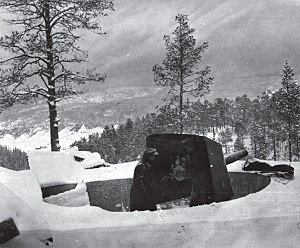| Battle of Hegra Fortress | |||||||
|---|---|---|---|---|---|---|---|
| Part of the Norwegian campaign | |||||||
 Norwegian 7.5 cm gun position | |||||||
| |||||||
| Belligerents | |||||||
|
|
| ||||||
| Commanders and leaders | |||||||
|
|
15–20 April: 20 April – 5 May: | ||||||
| Units involved | |||||||
|
|
(15–27 April) (27 April–5 May) | ||||||
| Strength | |||||||
|
Positional artillery:[4] 4×10.5 cm guns 2×7.5 cm guns (under Captain Evjen, with 25 men) Field artillery:[4] 4×8.4 cm guns (under 2nd Lieutenant Reitan, with 10 men) Total force:[5] 250 volunteer soldiers (most of whom had had a short national service with Artillery Regiment no. 3 (AR 3) before the war) 1 female volunteer nurse |
1 battalion 1 reinforced infantry company 1 artillery unit (with numerous mortars, cannons and howitzers)[6] | ||||||
| Casualties and losses | |||||||
|
6 killed 14 wounded[7] 200+ captured |
150–200 killed or wounded[7][8] 1 captured[9] 1 aircraft destroyed 1 aircraft damaged[10] | ||||||
|
Civilian casualties: One Norwegian civilian killed 2 Finnish civilian refugees wounded | |||||||
The Battle of Hegra Fortress was a 25-day engagement in the 1940 Norwegian campaign which saw a small force of Norwegian volunteers fighting numerically superior German forces from a fortified position. After initial fighting around the Meråker Line railway line, the Norwegians pulled back into Hegra Fortress and held off further German attacks before surrendering on 5 May as one of the last Norwegian units active in southern Norway.
- ^ Nissen, Hans; Kirkhusmo Anders (2007). "Hegra Festning". Historisk kilde- og kunnskapsbase for Trøndelag (in Norwegian). Sør-Trøndelag County Municipality, Trondheim municipality and the Norwegian Archive, Library and Museum Authority. Archived from the original on 14 August 2007. Retrieved 5 April 2010.
- ^ Brox 1988: 45
- ^ a b c d Brox 1988: 102
- ^ a b Brox 1988: 81
- ^ "Hegra Festning". Foreningen Hegra Festnings Venner (in Norwegian). 2009. Archived from the original on 26 March 2010. Retrieved 5 April 2010.
- ^ Cite error: The named reference
Brox88: 191was invoked but never defined (see the help page). - ^ a b Møller, Anders (24 November 2005). "Holtermann 08, Evne og Vilje til Handling". Norwegian Military Academy (in Norwegian). Retrieved 5 April 2010.[permanent dead link]
- ^ Brox 1988: 125
- ^ Brox 1988: 94
- ^ Soldat 1985: 14, 20